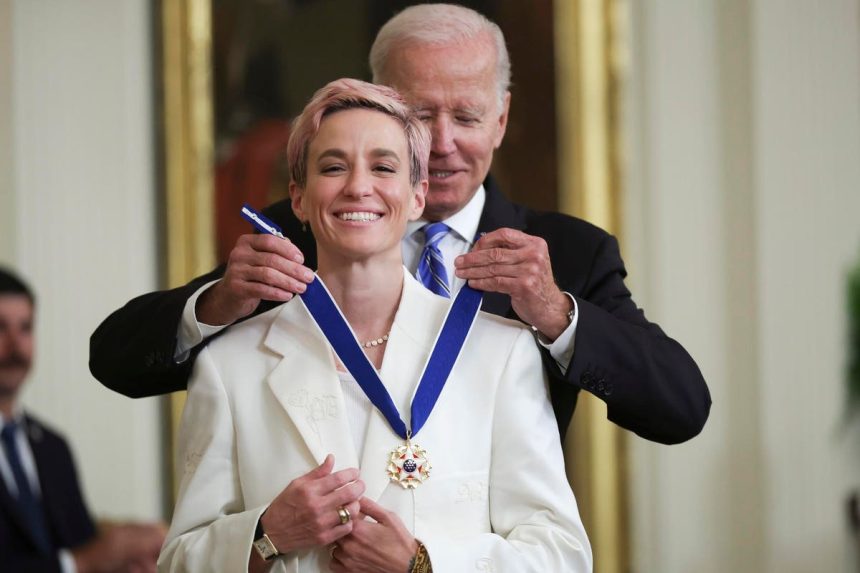The United States women have been narrowly knocked out of soccer’s World Cup in the round of 16, the earliest a US team has ever exited the tournament. And the always-divisive Donald Trump blamed the loss (somehow) on liberal policies, tweeting that “WOKE EQUALS FAILURE” (his caps). But in fact the US women have succeeded and inspired growth in the world’s game precisely because of legal policies supporting equal rights.
The loss came after a disappointing opening three matches, where the US struggled to score goals and seemed at a tactical loss against vastly improved teams from around the world. The striking improvement of women’s teams from all around the world, not just Europe, underscores how American women have set a positive example.
The USA used to just show up and dominate other teams through sheer physical prowess and playing experience. Sexism in other countries held back women playing the game. Places like Brazil, England, and France, long-standing world powers in men’s soccer, saw it only as a man’s game.
Women’s Soccer Success Rooted In Title IX
But women’s soccer didn’t grow in America because we were more enlightened. It grew here because we legislated equality in college sports through 1972’s Title IX of federal education law.
Title IX wasn’t mainly about sports, but about equal education. It was part of a political movement to enshrine women’s equal rights in law, inspired by the anti-racist civil rights movement.
Title IX banned sex discrimination in education, with its reach extending to college sports. Suddenly, colleges that had sunk millions into men’s sports, especially American football, had to build up women’s intercollegiate sports. Donna Lopiano, a former chief executive of the Women’s Sports Foundation, said “at the time schools were interested in ‘how can I add sports for women that wouldn’t cost me very much?’”
Women’s intercollegiate soccer was a cheap way to get lots of women into sports, and thus preserve existing scholarships and spending for men, especially in American football. As the New York Times documented, increased college access and scholarships in turn stimulated girls’ soccer in high school and below.
In 1974, just over 6400 girls played soccer in high school, mostly in New York. By 2018-19, that jumped nationally to over 394,000. Participation in other girls’ sports also rose, but soccer was a huge beneficiary.
Before Title IX, the Times reported that “an NCAA count found only 13 women’s collegiate soccer teams in the 1971-72 season, with 313 players.” With Title IX, women’s participation in the top three NCAA soccer divisions jumped to 1855 in 1981-82, and was 15 times higher (almost 28,000) in 2020-21, although it took continuing litigation and struggling for colleges to support equality.
The US women took the world by storm. In 1999, when Americans hosted the World Cup, the team led by Mia Hamm, Brandi Chastain, and other stars won the title in a penalty shootout against China, in front of over 90,000 spectators. (I coached my daughter and her elementary schoolmates’ team, and we all went to see the USA women in the opening round. Every time Hamm touched the ball, the stadium filled with high-pitched yells and cheers from thousands of young girls watching their hero.)
Women Soccer Players Advocate Equal Rights
USA’s women have always fought for equality and fair treatment. They engaged in a multi-year fight with the US Soccer Federation to get equal pay with American men, arguing they were more successful and also produced more revenue. In 2022, the Federation signed an agreement for equal pay and support, a landmark for women athletes in other countries.
They’ve also provided consistent leadership on gay and LGBTQ rights, recently exemplified by players like Megan Rapinoe, an openly gay player who also supports Black Lives Matter and is a strong women’s rights advocate. Sadly, Rapinoe missed her penalty kick against Sweden, a tough end to a distinguished career that includes two World Cup championships and an Olympic gold medal.
Trump went out of his way to mock and attack the outspoken Rapinoe, tweeting “Nice shot, Megan, the USA is going to Hell!!!)”
But Trump has it exactly wrong. It was America’s “woke” policy of equal rights for women that passed Title IX, and helped put our players at the top of the world game. In turn, they’ve inspired women here and around the world.
Economics Of Women’s Soccer Changing
The economics of women’s soccer now are changing in ways that encourage professional development over college participation, similar to men’s soccer. World class clubs like Arsenal, Chelsea, and Barcelona now have strong women’s teams and development programs, and this will mean major changes for American players.
College participation isn’t the main route to success anymore, and we must hope this helps girls who aren’t from higher-income college-oriented families and schools to be brought into America’s playing system. At the same time, this professionalization often has exploited younger, poorer men, and that needs to be avoided going forward for both men and women.
The World Cup loss and global growth of women’s soccer actually are signs of the long-term impact and success of America’s players, and of America’s still unrealized commitment to full and equal rights for women. (The Equal Rights Amendment to the Constitution was introduced in 1972, the same year Title IX passed. It still hasn’t been enacted.)
Contrary to Trump’s screed, the long-term success of American women in the world’s game is directly rooted in political advocacy and the resulting legal steps for women’s equality.
Read the full article here










